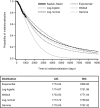Determinants of time to institutionalisation and related healthcare and societal costs in a community-based cohort of patients with Alzheimer's disease dementia
- PMID: 30178148
- PMCID: PMC6438944
- DOI: 10.1007/s10198-018-1001-3
Determinants of time to institutionalisation and related healthcare and societal costs in a community-based cohort of patients with Alzheimer's disease dementia
Abstract
Objectives: To examine the costs of caring for community-dwelling patients with Alzheimer's disease (AD) dementia in relation to the time to institutionalisation.
Methods: GERAS was a prospective, non-interventional cohort study in community-dwelling patients with AD dementia and their caregivers in three European countries. Using identified factors associated with time to institutionalisation, models were developed to estimate the time to institutionalisation for all patients. Estimates of monthly total societal costs, patient healthcare costs and total patient costs (healthcare and social care together) prior to institutionalisation were developed as a function of the time to institutionalisation.
Results: Of the 1495 patients assessed at baseline, 307 (20.5%) were institutionalised over 36 months. Disease severity at baseline [based on Mini-Mental State Examination (MMSE) scores] was associated with risk of being institutionalised during follow up (p < 0.001). Having a non-spousal informal caregiver was associated with a faster time to institutionalisation (944 fewer days versus having a spousal caregiver), as was each one-point worsening in baseline score of MMSE, instrumental activities of daily living and behavioural disturbance (67, 50 and 30 fewer days, respectively). Total societal costs, total patient costs and, to a lesser extent, patient healthcare-only costs were associated with time to institutionalisation. In the 5 years pre-institutionalisation, monthly total societal costs increased by more than £1000 (€1166 equivalent for 2010) from £1900 to £3160 and monthly total patient costs almost doubled from £770 to £1529.
Conclusions: Total societal costs and total patient costs rise steeply as community-dwelling patients with AD dementia approach institutionalisation.
Keywords: Alzheimer’s disease; Caregiver; Institutionalisation; Predictors; Societal costs.
Conflict of interest statement
Conflict of interest
MB, CR and MH are employees and shareholders of Eli Lilly and Company. JMH, JMA, GB, RD, RWJ, BV and AW have received financial compensation from Eli Lilly for participation in the GERAS Advisory Board. JMH has received financial compensation from Otsuka, Roche and Lundbeck for participation in advisory boards. RD has received research funding, honoraria and financial compensation for consultancy or advisory board membership from a number of pharmaceutical companies including Abbott/AbbVie, Baxter, Eli Lilly, Novartis, Octapharma and Pfizer and from some medical societies. RWJ has received honoraria for speaking at/chairing symposia and has been a member of advisory boards for Eli Lilly. AW has received financial compensation from Lundbeck, Novartis, Biogen and Roche for participation in advisory boards.
Informed consent
The GERAS study was approved by ethical review boards in accordance with country-specific regulations. Written informed consent was obtained from all participants or their legal representative.
Figures



References
-
- Wübker A, Zwakhalen SM, Challis D, Suhonen R, Karlsson S, Zabalegui A, Soto M, Saks K, Sauerland D. Costs of care for people with dementia just before and after nursing home placement: primary data from eight European countries. Eur. J. Health Econ. 2015;16(7):689–707. doi: 10.1007/s10198-014-0620-6. - DOI - PubMed
Publication types
MeSH terms
Grants and funding
LinkOut - more resources
Full Text Sources
Other Literature Sources
Medical

